By Kevin Armstrong
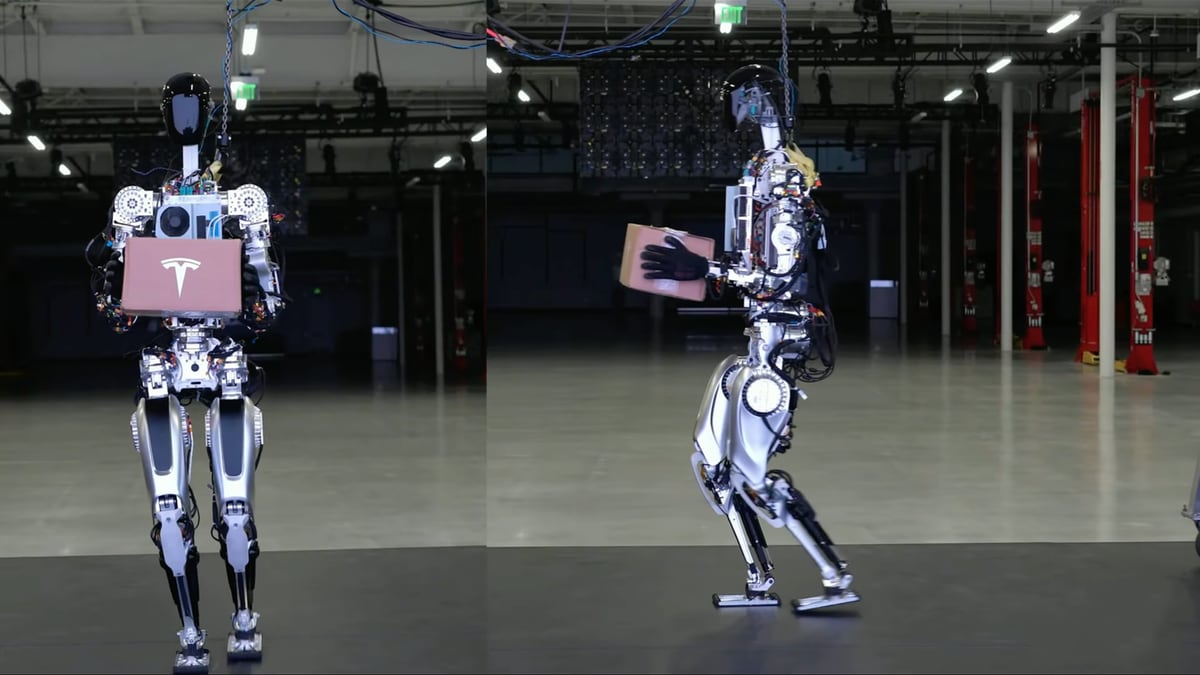
Elon Musk started Tesla's AI Day 2022 by saying, "I want to set some expectations with respect to our Optimus Robot," just before the doors opened behind him. A robot walked out, waved at the audience, and did a little dance. Admittedly a humble beginning, he explained, "the Robot can actually do a lot more than what we just showed you. We just didn't want it to fall on its face." Musk's vision for the Tesla Robot, "Optimus is going to be incredible in five years, ten years mind-blowing." The CEO said other technologies that have changed the world have plateaued; the Robot is just starting.
Tesla's CEO envisions Optimus eventually being like Commander Data, the android from Star Trek the Next Generation, except it "would be programmed to be less robot-like and more friendly." Undoubtedly there is a long way to go to achieve what Doctor Noonien Soong created in Star Trek TNG. What was demonstrated onstage wasn't at that level, but several videos throughout the presentation highlighted what the Robot is capable of at its very early stage in development. The audience watched the Robot pick up boxes, deliver packages, water plants and work at a station at the Tesla factory in Fremont.
Development over 8 Months
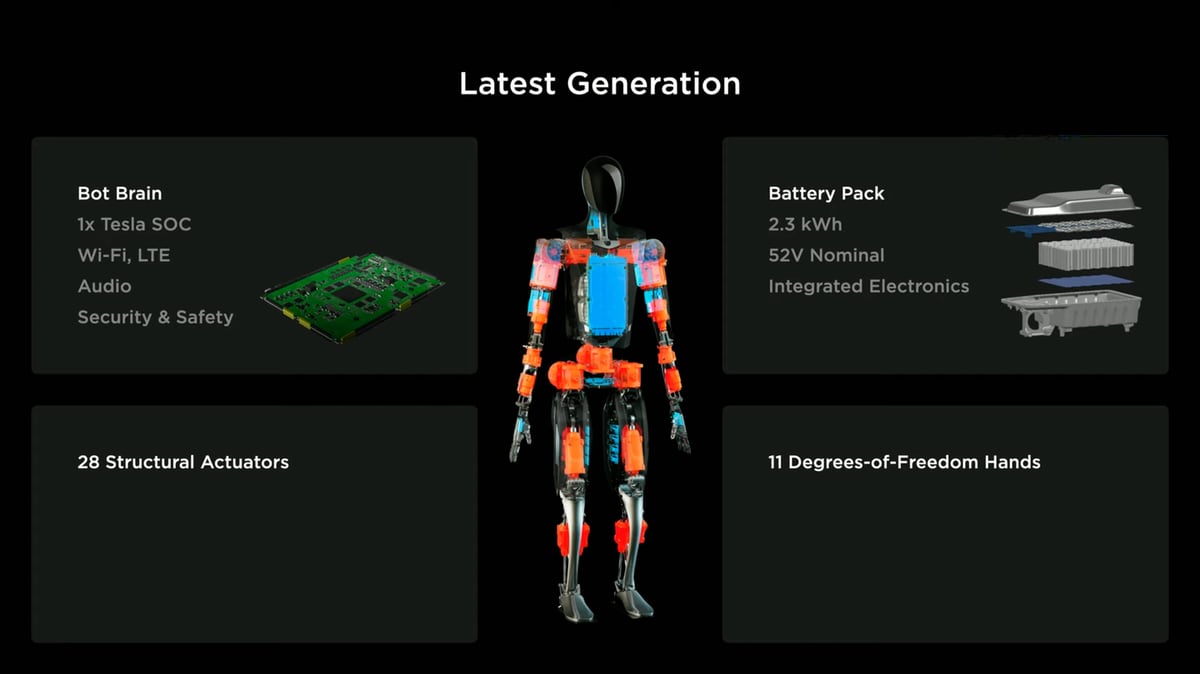
The first Robot to take the stage at AI Day was not Optimus, but Bumble C, another acknowledgement to The Transformers, as Bumble Bee played a significant role in that franchise. However, Bumble C is far less advanced than Optimus, who did appear later but was on a cart.
Several Tesla engineers took turns on the microphone describing some of the most complex elements of the project that was first announced one year ago. Perhaps the best description of the project was the company moving from building a robot on wheels to a robot on legs. However, that may be oversimplifying. For example, the car has two motors, and the Robot has 28 actuators.
Overall Design and Battery Life
Tesla's brightest demonstrated how the production has come to life over the past eight months. It seems this group of computer masterminds had to become anatomist experts as Tesla took hints from the human body to create a humanoid robot. That is an essential factor in creating Optimus. Everything people interact with is made usable by a human, with two legs, two arms, ten fingers etc. If the Robot differed from what the world is already designed for, everything would have to change. However, recreating the human body and its countless movements would take far too long, so Tesla has stripped it down to less than 30 core movements, not including the hand.
Like the human torso contains the heart, the Robot's chest holds the battery. It's projected that a single charge would provide enough for a full day's work with a 2.3-kilowatt-hour battery. All the battery electronics are integrated into a single printed circuit board within the pack. That technology keeps charge management and power distribution all in one place. Tesla used lessons learned from vehicle and energy production to create the battery allowing for streamlined manufacturing and simple and effective cooling methods.
Autopilot Technology
Tesla showed what the Robot sees, and it looked very familiar. That's because the neural networks are pulling directly from Autopilot. Training data had to be collected to show indoor settings and other products not used with the car. Engineers have trained neural networks to identify high-frequency features and key points within the Robot's camera streams, such as a charging station. Tesla has also been using the Autopilot simulator but has integrated it for use with the Robot programming.
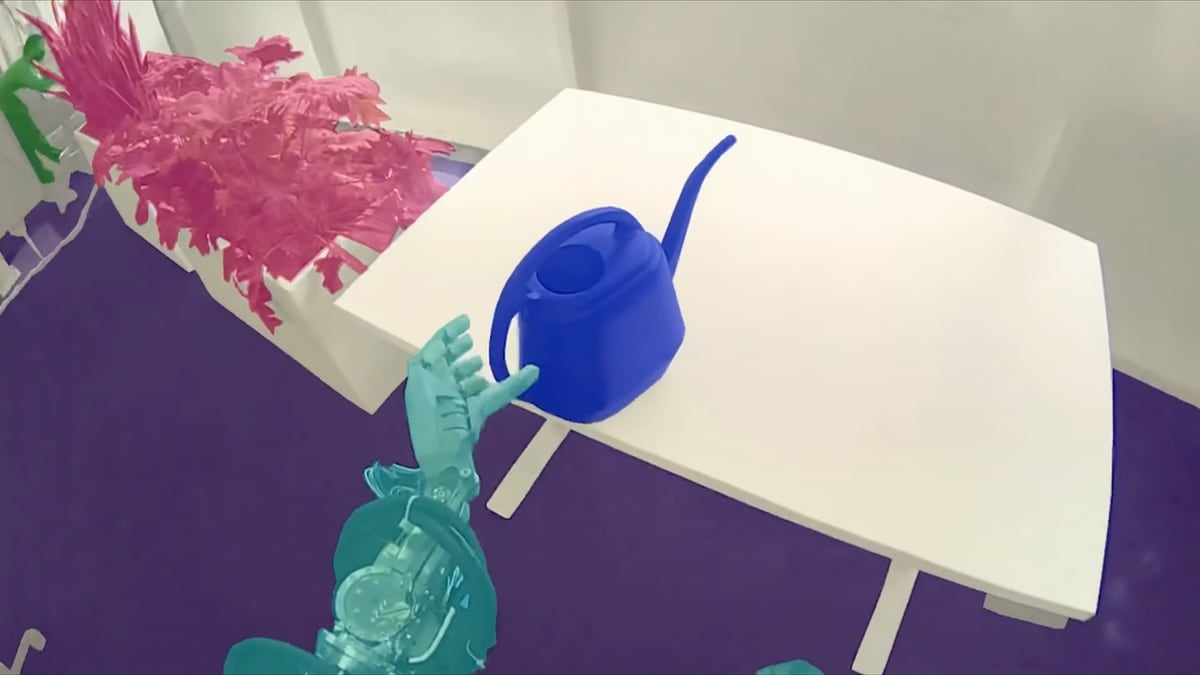
The torso also contains the centralized computer that Tesla says will do everything a human brain does, such as processing vision data, making split-second decisions based on multi-sensory inputs and supporting communications. In addition, the Robot is equipped with wireless connectivity and audio support. Yes, the Robot is going to have conversations, "we really want to have fun, be utilitarian and also be a friend and hang out with you," said Musk.
Motors Mimic Joints
The 28 actuators throughout the Robot's frame are placed where many joints are in the human body. Just one of those actuators was shown lifting a half-tonne nine-foot concert grand piano. There have been thousands of test models run to show how each motor works with the other and how to effectively operate the most relevant actuators for a task. Even the act of walking takes several calculations that the Robot must make in real-time, not only to perform but also appear natural. The robots will be programmed with a locomotion code; the desired path goes to the locomotion planner, which uses trajectories to state estimations, very similar to the human vestibular system.
Human hands can move 300 degrees per second and have tens of thousands of tactile sensors. Hands can manipulate anything in our daily lives, from bulky, heavy items to something delicate. Now Tesla is recreating that with Optimus. Six actuators and 11 degrees of freedom are incorporated into the robot hand. It has an in-hand controller that drives the fingers and receives sensory feedback. The fingers have metallic tendons to allow for flexibility and strength. The hands are being created to allow for a precision grip of small parts and tools.
Responsible Robot Safety
Musk wanted to start AI day with the epic opening scene from Terminator when a robot crushed a skull. He has heard the fears and people warning, "don't go down the terminator path," but the CEO said safety is a top priority. There are safeguards in place, including designs for a localized control ROM that would not be connected to the internet that can turn the Robot off. He sees this as a stop button or remote control.
Musk said the development of Optimus may broaden Tesla's mission statement to include "making the future awesome." He believes the potential is not recognized by most, and it "really boggles the mind." Musk said, "this means a future of abundance. There is no poverty. You can have whatever you want in terms of products and services. It really is a fundamental transformation of civilization as we know it." All of this at a price predicted to be less than $20,000 USD.
Tesla Shows Off its First Robot at AI Day 2
By Nuno Cristovao
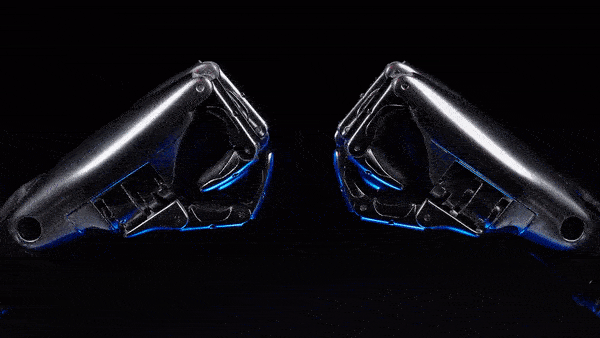
Tesla is hosting its recruiting event, AI Day 2 tonight in Palo Alto, California.
Elon Musk said to expect a lot of technical detail and "cool" hardware demos. We don't know which demos exactly, although Elon did say the event will be focused on AI and robotics.
Elon also talked about how these events are specifically aimed at showing off the exciting things Tesla is working on to attract more talent.
We can expect Tesla to show off its new Tesla bot, Optimus, talk about FSD and AI and possibly share some details on FSD hardware 4.0 and its upcoming Steam integration.
Pretty much. AI/robotics engineers who understand what problems need to be solved will like what they see.
— Elon Musk (@elonmusk) September 29, 2022
Start Time
The event took place in Palo Alto, CA on September 30th at 6:15 pm PT.
Watch on Demand
You can watch the event on demand below:
By Nakatomi2010
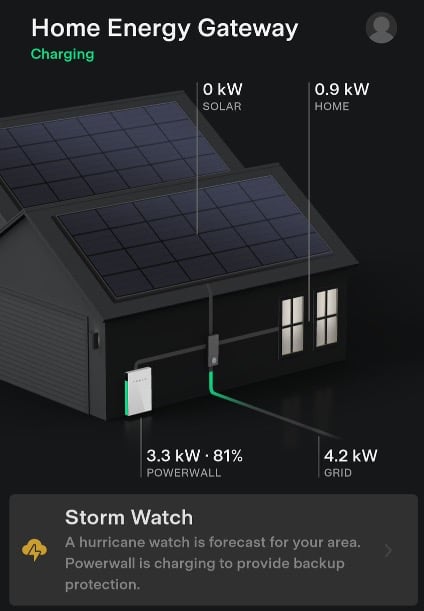
Back in 2017, I was in a home with solar panels, but no battery backup. Hurricane Irma passed overhead, and I found myself without power for 24-48 hours. We lost all of our food as a result.
When the storm passed, I called up the company that installed my solar panels and found that adding in a battery would be cost-prohibitive, as it would require replacing the solar inverter. As my wife and I started shopping for a new home for our family, I kept this information in mind as I had planned on having solar+battery put in at the new house. I worked on finding a home that would be oriented properly to get the best solar collection capacity, and we bought it in 2018.
Once the home was bought I went through the process of getting quotes for solar + battery arrays and ultimately settled on Tesla.
Tesla was largely chosen because, at the time, the Powerwall battery had the shortest cutover time in the event of an outage. It kicks in right away, while the others took 2-3 seconds to switch over.
By the end of 2018, the array and Powerwall were installed and operational. The array has a max output of 9.425 kW using a SolarEdge SE7600H-US inverter, which has a max output of 7.64 kW, and a single Gen 2 Powerwall 2. During the design, I chose not to have the HVAC and car chargers run off the Powerwall.
As Hurricane Ian approached, Tesla's Storm Watch kicked in on the Powerwall.
The Powerwall started charging to 100% about two days before the hurricane made landfall. I debated on letting the Powerwall’s power get used leading up to landfall, but having been through hurricanes before, I opted to let Storm Watch do its thing. As the hurricane approaches it’s not uncommon for the winds to cause power stability issues. Leading up to the hurricane the power blinked numerous times.
By the afternoon of September, 28th people in the Tampa area were already starting to lose power.
At around 4:15-4:30 pm, as the winds outside were getting stronger, my wife and I decided to start making dinner for the kids. For reasons unknown, we decided to cook some things that involved the stove. At 4:42 pm the power blinked, and the Powerwall took over for about 5 minutes, putting us back on the grid at 4:47 pm. Once back on the grid the Powerwall charged back up to 100%.
At 5:03 pm on September 28th, the power went out again. After making dinner, we turned off the appliances and watched Andor on Disney+.When it was over I looked at the Powerwall’s status and found that we were now down to 91%.
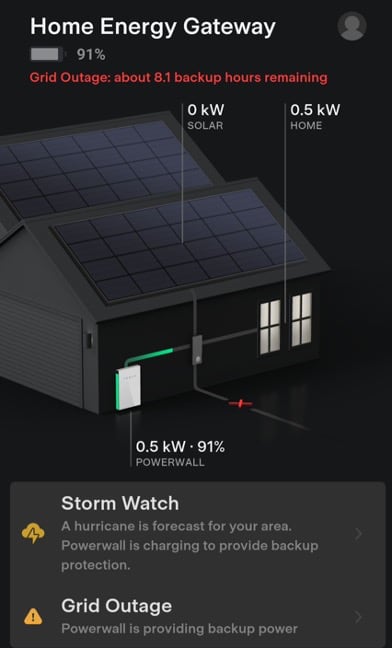
There was a notice that said we had about 8.1 hours of power remaining, I started to cycle through the things in the house that consumed power and began shutting them off, either at the breaker box, or by unplugging them, intending to ensure there was enough power to keep our fridge, and a chest freezer in the garage online.
I was able to get us down to about .3-.4 kW of use before going to bed and hoped that was enough. Things that were turned off were the water heater, the dishwashers, computer gear, TVs, etc. Anything that might have vampire drain in the long run, including the internet gear.
At around 7 pm yesterday, two hours after the power had gone out, Tesla sent me an email with the VIN for my new Model Y.
I couldn't help but chuckle at their timing.
I woke up the next morning, September 29th, at around 6:30 am. I had to connect to the Powerwall directly to check the stats since I had powered down the internet gear and Gen 2 Powerwalls don’t have cellular connectivity any longer due to AT&T's 3G network being shut down earlier this year. I found that the Powerwall was down to 46%.
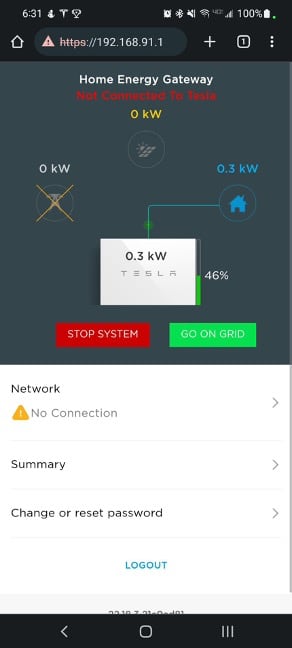
By this time the storm had moved beyond my area, and I went outside to start inspecting for potential property damage and such. Thankfully, we were spared property damage. The most we had was a panel that covers the service box for our internet cables get blown off the side of the house. I found it about 4 feet away and put it back on.
Others in the community I live in were less fortunate. Several smaller trees had been tipped over, some homes had shingles blown off their roof, and in at least one case a tree had fallen on top of a vehicle.
At 8 am I checked to see how many people in my neck of the woods were without power and found that the total increased from 21,2000 to 292,247 as the hurricane moved away.
The day after a hurricane is a tricky one, particularly if the hurricane is a big one because there’s still a lot of cloud cover. By around 8:38 am the Powerwall was at 36% charged and the sun was barely peaking out around the clouds, resulting in a lower power generation rate.
About 30 minutes later, at 9:10 am, enough sun was shining through the clouds for the Powerwall to start charging.
35% would be as low as the Powerwall went during this event.
As the day went on, we used power sparingly, mostly trying to ensure our mobile devices were charged. We used a microwave and a toaster oven to make breakfast, and at around 11 am I got a chuckle at my impact card showing 0% grid usage.
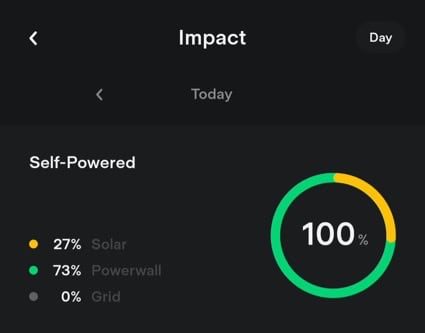
By lunchtime, the Powerwall showed Storm Watch was over, and the Powerwall was charged to 68%.
So we again used the microwave and toaster oven to make lunch and feed the family.
At around 1 pm the Powerwall started to hit around 80-85% charged, and we started running into an issue with generating power. Every time the Powerwall generated more than 5kW of power, we got an error that read “DC VOLTAGE NOT SAFE! DO NOT DISCONNECT! VDC 445.4”
Followed by another “Error code 18x40 AC Freq too high”
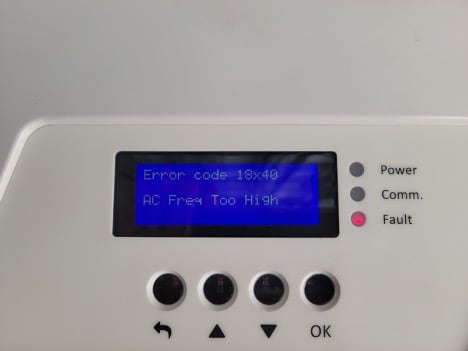
And then it would go to “Waking up…” and start a five-minute timer. Once the five-minute timer was done, the cycle would repeat, the array would generate 5 kW, give an error, and reboot.
I tried to open a support ticket with Tesla, first using the Tesla app. I started a chat session with someone who immediately disconnected the chat session saying “Weather-related issue”, as I was not on the grid.
Irritated, I re-opened the chat session and got a different person who worked with me.
Initially, the individual claimed that the issue was related to the overcast sky, however, that wasn’t the case as the inverter *does* shut down when there’s a lack of sunshine. In this case, it was shutting off every time it hit 5 kW generation. While still on chat support I used a different mobile device to call Tesla's solar number. I received different answers from the chat advisor and the representative on the phone.
Chat support said that there did appear to be an issue and advised me to schedule a service ticket, and ended the chat.
The person on the phone took the time to explain to me what was happening, and ultimately resolved the issue. The Powerwalls are limited to 5 kW of intake. As I only had one Powerwall, once the array generated more than 5 kW of Power, the Powerwall was changing the frequency to tell the array “Whoa, stop, you’re giving me too much power”, which would reboot the array for five minutes, and repeat the cycle.
The solution to this issue is rather amusing.
You have to use more power to use the excess energy that the array is generating.
Armed with this new information I turned back on the dishwasher and the water heater, and started doing dishes, taking a shower, and watching TV. We eventually found a happy medium where we were using enough power to have the Powerwall stop shutting off the array and continue charging.
From 2 pm to 4 pm we greedily used power, but at 4 pm the intake wasn’t as good anymore as the sun was starting its trek to go below the horizon.
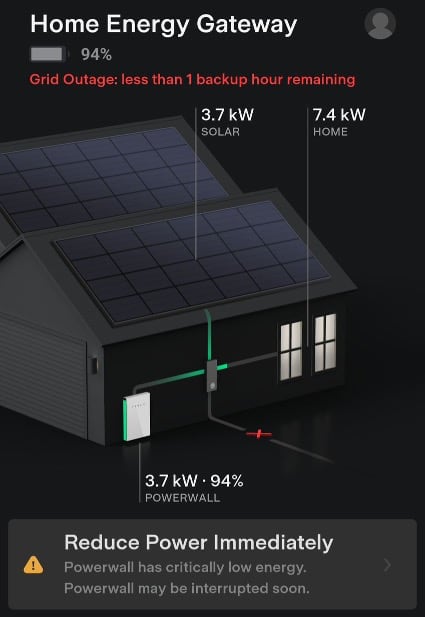
After the dishwasher finished, I turned the water heater and dishwasher back off and started going back to “low power” mode as we began making an early dinner, again, using the toaster ovens, and an air fryer.
We took some time to eat our food while watching TV, catching up on Paramount+’s Lower Decks, and Disney+’s She-Hulk, and we started turning things off again.
By 6:22 pm the Powerwall reached 98%. The sun finally went low enough on the horizon for power to stop being generated.
By the end of the day when we getting ready for bed, we still had no power.
By 2:15 am, on September 30th, I awoke to go pee, then sat on the edge of the bed and decided to check the Powerwall’s state of charge. I found it to be at 45% and heard a rumbling outside the bedroom door that turned into a roar.
After initially thinking it was an Amazon plane flying overhead, I got up and checked the thermostat to find that the HVAC had turned back on again. After checking the Tesla app again I found that power had been restored.
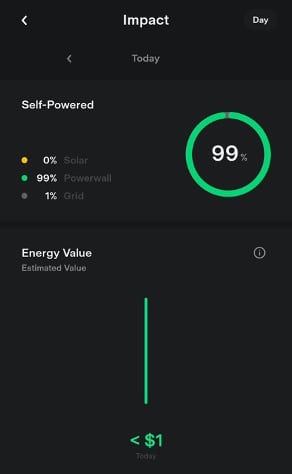
Looking at the Impact card to try and see how long the outage was, I realized that Tesla’s app doesn’t seem to know how to handle an outage that’s longer than a day.
The power went out at 5:03 pm on Wednesday, September 28th, and ultimately returned at 2:17 am on Friday, September 30th. A total of about 32 hours being off-grid.
What would I do differently? Tough to say honestly.
Having to go to the garage to flip breakers to reduce or increase the power load was annoying, putting in a Smart breaker panel would’ve been beneficial, but only so long as we had internet access.
A second Powerwall would’ve been very beneficial as it would have allowed me to not have to increase the power load to ensure the Powerwall kept charging properly, as the power would’ve likely been split between them. If and when Tesla sells Powerwalls without requiring solar with it, this is an option I’ll be investigating for sure, as long as it isn’t cost-prohibitive. I’m uncertain if you can mix and match a Gen 3 Powerwall with a Gen 2 under a SolarEdge inverter.
Not having the HVAC, while unpleasant, wasn't a huge deal. After a hurricane clears out of an area, you’re generally left with a lot of cold air, so we just opened the windows for a bit. Having EV chargers was also a non-issue because we didn’t drive anywhere, and the cars only lost about 2-3% charge, mostly from me opening the Tesla app and accidentally waking up the cars while trying to scroll to the Solar card.
Bagikan Berita Ini
















0 Response to "Everything we know about Optimus, the Tesla Robot - Not a Tesla App"
Post a Comment